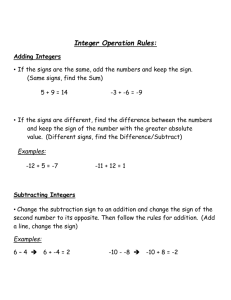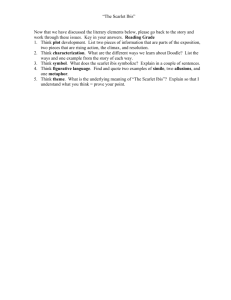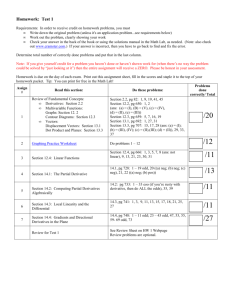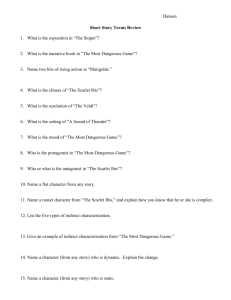Document
advertisement
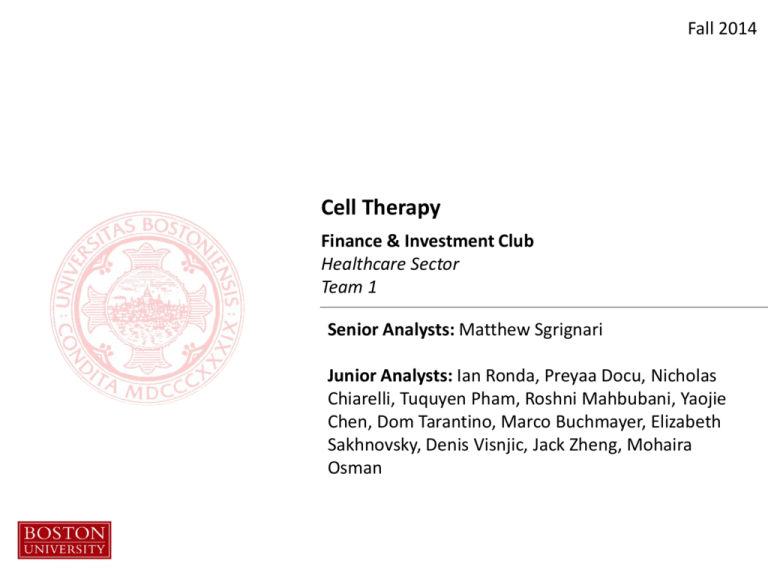
Fall 2014 Cell Therapy Finance & Investment Club Healthcare Sector Team 1 Senior Analysts: Matthew Sgrignari Junior Analysts: Ian Ronda, Preyaa Docu, Nicholas Chiarelli, Tuquyen Pham, Roshni Mahbubani, Yaojie Chen, Dom Tarantino, Marco Buchmayer, Elizabeth Sakhnovsky, Denis Visnjic, Jack Zheng, Mohaira Osman Industry Overview Industry Life Outlook: Neutral Cell Therapy Revenue Projection Revenue in Millions 3000 2500 2000 1500 1000 500 0 2006 2007 2008 2009 2010 2011 2012 2013 2014 2015 2016 2017 2018 2019 Years Industry Statement: The cell therapy industry is expected to grow rapidly from 2015-2019, however this growth is difficult to quantify and highly volatile making the industry an overly risky investment in the next 2 years Upside Potential: High Anticipated Growth New Products Increasing Investment Downside Potential: Regulation Volatility Non-Receptive Market Index Industry Definition: The cell therapy industry researches, develops, and manufactures therapies using engineered human tissue for regenerative medicine and human cytotherapy. The industry is very new, marked by the regular implementation of bone marrow transplants in 1990. Cell therapy is currently being watched for its massive growth potential with dozens of new therapies in development. Procedures include cancer cell therapy, musculoskeletal cell therapy, as well as mainstream medicine (transfusions) and alternative medicine (stem cells). Companies consist of mainly small startups with heavy backing from big pharma. NASDAQ:DNDN NASDAQ:SHPG NASDAQ:NUVA IBIS World, S&P Capital Private NASDAQ:OFIX Index Industry Breakdown: Industry Breakdown by Revenue (US) Cell Therapy Market Share (US) other 20% Healthcare $2595B Shire Dendreon Regenerative 31% 15% Orthofix 17% 100.0% Pharma/Ther apies Nuvasive 6% 262B Organogensis 11% Price Weighted Index 10.9% 25 Cell Therapy 20 1.048B 10 .04% IBIS World, S&P Capital, Investext 15 5 0 Index Business Model: Cell Therapy 3-Step Process Processing & Research Manufacturing Funding Discovery Creation Process Therapies Engineered from NonHuman Cell Matter Completion IBIS World, S&P Capital Hospitals and Treatment Facilities Distribution Process Patients + FDA Interaction Treatment Therapies Direct from Human Cellls Other Manufacture rs Index Revenue Generation Testing in Vitro Raw Materials Harvesting/Sy nthesis Therapy Designing Animal Testing Phase I: Safety Engineerin g Therapy Prepared Cell Harvesting Treatment Facility Phase II: Sick Patients Allogenic Phase III: Longer Periods Larger Groups New Therapy Application Approval Discovery Autologus Injections to Patients Products Preseverved Final Products Ready Manufacturing S&P Capital, IBIS World ,Company 10-Ks Final Therapy in Progress Distribution Index Industry Competitive Landscape Porter’s Five Forces Analysis Power of Suppliers: Low -Short Term Supplier Contracts -Industry Harvests Many Inputs Industry Rivalry Barriers to Entry: Moderate -Significant Regulatory Barriers -Low Capital Intensity -High Availability for R&D Financing -Very Skilled Talent Pool Required -High Wage Costs Moderate Threat of Substitutes: Low -Well Integrated Firms Still Subject to Industry Risks -Small Firms Can Enter With Promising Products -Difficulty to establish long term product superiority -Patent Protection for Periods of Time -Regulatory Requirements Discourage Replication -Treatments Targeted at Previously Unaddressed Illnesses Power of Buyers: Moderate -External Options Threaten Therapies -Health Insurance Limits Products Eligible -Highly Fragmented Market -LowBloomberg bargaining power S&P Capital IBISWorld, Company 10-Ks, Index Trends Developing Therapy Pipeline Decrease in PHE Overcoming Wage Costs Index Trend 1: Developing Therapy Pipeline Cell therapy firms have an expected 8-15 year drug timeline that started at the industries formal inception around 2000 The FDA’s Safety and Innovation Act (2012) created a fast track for “break through therapies” to expedite phases II&III of clinical trials Years Products in Pipeline 2013 Other Central… Expected Passing Products Gastro Cardiovascular Based on industry revenue projections revenue is expected to grow at a CAGR of 17.3% from 2014 to 2017 based on the expectation of 26 successful new products. Phase II & III Oncology Musculoskele… Phase I Enodocrine Dermatology 0 5 10 15 Number of Products IBIS World, S&P Capital, FDA, CT Coalition 2019 2018 2017 2016 2015 2014 2013 2012 2011 2010 2009 2008 2007 3000 2000 1000 0 2006 Revenue in Millions Cell Therapy Revenue Projection Index 20 Trend 1: Cont. If the industry does not deliver on the number of products estimated or the public does not take to the therapies then the industry revenue will sink IBIS World, S&P Capital, FDA, CT Coalition Revenue Growth 2014-2017 These two variables: -Product Completion -Revenue per Products Are the key determinants of industry revenue growth and are both subject to high degrees of volatility Revenue Growth Sensitivity to Product Success 70.0% 60.0% 50.0% 40.0% 30.0% 20.0% 10.0% 0.0% 5.0% 15.0% 25.0% 35.0% 45.0% %of Products Completed by 2017 Revenue Growth Sensitivity to Revenue/Product Revenue Growth 2014-2017 Analysts currently project cell therapy revenue to reach 2.07B by 2017, a projection based on the release of 27% of therapies in the pipeline generating about 40M per therapy 120.0% 100.0% 80.0% 60.0% 40.0% 20.0% 0.0% 20 60 80 100 Revenue per Product (M) Index 120 Trends Developing Therapy Pipeline Decrease in PHE Overcoming Wage Costs Index Trend 2: Decreasing Growth in Private High development costs for cell Expenditure therapy treatments lead to high Private Expenditure as % of Total costs for patients. Patients pay private insurance/out of pocket Healthare Expenditure PE % of HE 0.6 Strong correlation between growth of CT revenue and private health expenditure (2011 Provenge) Slow relative growth in private healthcare expenditure and shift towards public plans can harm CT revenues in the next 5 years 0.5 0.45 0.4 2008 2009 2010 2011 2012 2013 2014 2015 2016 2017 2018 Year Y/Y Growth of CT Revenue vs. PHE % Annual Growth ACA Expected Growth: Healthcare 2014 7.4% 2015-2018 CAGR 6.2% Private 2014 5.2% (Insurance 6.8%) 2015-2018 CAGR 4.39% 0.55 IBIS World, S&P Capital, ACA, World Bank 60.00% 55.00% 50.00% 45.00% 40.00% 35.00% 30.00% 25.00% 20.00% 15.00% 10.00% 5.00% 0.00% Correlation 0.705225993 2005 2006 2007 2008 2009 2010 2011 2012 Year Cell Therapy Revenue Private Health Expenditure US Index 2013 Trends Developing Therapy Pipeline Decrease in PHE Overcoming Wage Costs Index Trend 3: Overcoming Wage Costs The average salary for workers in Wage expenses in 2013 exceeded revenue by $193.7 million (118.5% of revenue) Research consolidation and efficiency have allowed the industry to generate more revenue per employee, up to $90,700 in 2013. Revenue vs. Wages 2500 2000 1500 1000 500 0 2004 2005 2006 2007 2008 2009 2010 2011 2012 2013 2014 2015 2016 2017 2018 Revenue/Employee $180,000.00 $160,000.00 1 to .07 ratio of labor to capital expenditures If revenues exceed wages in 2015 the industry will have overcome its largest internal cost IBIS World, S&P Capital, FDA, CT Coalition Wages Millions CT was $107,422 in 2013, primarily PHDs & researchers $140,000.00 CAGR 18.09 % $120,000.00 $100,000.00 $80,000.00 $60,000.00 $40,000.00 $20,000.00 $0.00 200420052006200720082009201020112012201320142015201620172018 Index Industry Risks & Challenges: Primary Risks to Cell Therapy Industry Losses in Funding Industries •Much of the funding in the industry comes from Pharma and Biotech companies leasing and investing in products. •If these companies faces losses in upcoming patent cliffs they may choose to cut funding in projects not generating revenue. External Solutions •Other areas of medicine are exploring ways to cure many of the currently incurable conditions that cell therapy looks to address •If these firms are successful patients will quickly transition to these treatments if they are covered by insurance or recommended by physicians Failure to Survive Periods of Loss • The industry is currently facing yearly losses • Companies have been entering and exiting the industry based on this lack of profitability and products can only be seen to fruition of companies can survive long enough to complete them IBIS World, S&P Capital, FDA, CT Coalition Index Industry Overview Industry Outlook: Neutral Industry Statement: The cell therapy industry is expected to grow rapidly from 2015-2019, however this growth is difficult to quantify and highly volatile making the industry an overly risky investment in the next 2 years Trends Decrease in Private Health Expenditure Decreasing Wage Costs/Increasing Revenue Risks Losses in Funding External Solutions Failure to Survive Losses 2250 Revenue in Million Developing + Volatile Drug Pipeline Cell Therapy Projected Revenues 2000 1750 1500 1250 1000 750 2013 2014 2015 2016 2017 Year Analysts Estimate 15% Product Success 20m Per New Product Index Key Financials Company Mkt Cap % of 52 (m) Week High Closing P/E Ratio EPS Total Debt/EBITD EV/EBITDA A ROE R&D/Op Exp NUVA 2067.0 96.85% 43.93 NEG -0.40 30.20 5.10 -3.00 0.07 DNDNQ 22.0 3.92% 0.14 NEG -1.06 NEG NEG - 0.13 OSIR 451.0 71.43% 13.15 NEG -0.08 NEG NEG -82.90 0.24 OFIX 514.0 75.66% 27.92 2792.00 0.01 37.80 1.40 -7.90 0.09 NBS 141.0 47.53% 3.94 NEG -1.84 NEG NEG -113.10 0.42 BLUE 1188.0 94.03% 41.23 2.30 18.01 NEG 0.00 -17.80 0.69 High 2067.0 96.85% 43.93 2792.00 18.01 37.80 5.10 -3.00 0.69 Low 1188.0 3.92% 0.14 2.30 -1.84 30.20 0.00 -113.10 0.09 59.5 73.55% 20.54 1397.15 -0.24 34.00 1.40 -17.80 0.19 730.5 64.90% 21.72 465.72 2.44 11.33 1.08 -37.45 0.27 Median Mean Investext, Bloomberg, Company 10Ks Index Index Industry Overview Industry Definition Industry Breakdown Business Model Revenue Generation Industry Competitive Landscape Trend 1: Developing Therapy Pipeline Trend 2: Decreasing Growth in Private Expenditure Trend 3: Overcoming Wage Costs Industry Risks & Challenges Closing Key Financials Index
